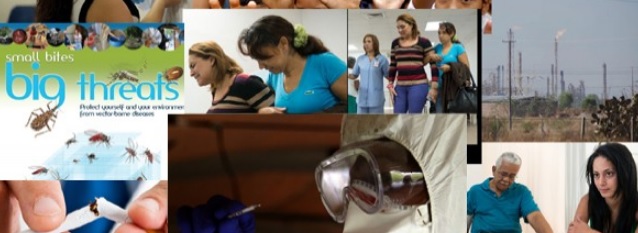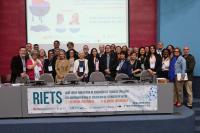PAHO year in review: 2014 public health highlights in the Americas
 The regions countries advanced toward goals including universal health coverage, expanded access to vaccination, and ensuring that fewer babies are born with HIV. They also confronted major new challenges, including the arrival and spread of the chikungunya virus and the need to prepare for the possible imported cases of Ebola.
The regions countries advanced toward goals including universal health coverage, expanded access to vaccination, and ensuring that fewer babies are born with HIV. They also confronted major new challenges, including the arrival and spread of the chikungunya virus and the need to prepare for the possible imported cases of Ebola.
The year 2014 was marked by progress as well as significant challenges for public health in the Americas. The regions countries advanced toward goals including universal health coverage, expanded access to vaccination, and ensuring that fewer babies are born with HIV. They also confronted major new challenges, including the arrival and spread of the chikungunya virus and the need to prepare for the possible imported cases of Ebola.
Below are highlights of major public health achievements and challenges on which the Pan American Health Organization/World Health Organization (PAHO/WHO) has collaborated with its member countries in the Americas.
Advancing toward health for allIn Latin America and the Caribbean, some 30% of the population lacks access to health care for economic reasons. In September 2014, health authorities from throughout the region gathered at PAHO/WHO and agreed on a regional strategy to advance the goal of universal access to health and universal health coverage. We have agreed on a roadmap to progressively ensure that all people have access to the health services they need, when they need them, without fear of financial hardship, said Carissa F. Etienne, PAHO/WHOs Director. A special Lancet series published in October highlighted progress in the Americas toward the goal of universal coverage.
Chikungunya affects 1 million people in the Americas Chikungunya, a mosquito-borne virus imported from Africa, produced its first locally transmitted case in the Americas in December 2013. During 2014, the virus spread from the Caribbean to other countries, infecting more than 1 million people throughout the Americas. PAHO/WHO helped member countries cope with the diseasethrough support for surveillance, detecting and managing cases, and preparing and organizing health services. Eliminating mosquito breeding sites helps reduce transmission.
Preparing Latin America and the Caribbean for potential Ebola In August 2014, WHO declared West Africas Ebola outbreak a public health event of international concern. Since then, PAHO/WHO has been working with member countries in the Americas to ensure they are able to respond rapidly and prevent the spread of any importation of the disease. Preventing local transmission is the main goal, said Marcos Espinal, director of PAHO/WHOs Department of Communicable Diseases and Health Analysis.
Dengue deaths decline in the Americas The case-fatality rate for dengue in the Americas declined more than 28% in the last three years, from 0.07% to 0.05%. A major contributing factor was better clinical management of patients following the dissemination of new PAHO/WHO guidelines in 2010. PAHO/WHO estimates that some 1,500 dengue deaths were prevented last year as a result of better care. On the downside, the number of dengue cases increased fivefold in the Americas between 2003 and 2013. This year, PAHO/WHOs World Health Day campaign focused on the threat of vector-borne diseases, or diseases transmitted by small insects, which include dengue.
More antiretroviral therapy, fewer infected babies, and new goals for 2020 A 2014 PAHO/WHO report showed that the number of people with HIV in Latin America and the Caribbean who receive antiretroviral therapy increased nearly fourfold between 2003 and 2013. Another PAHO/WHO and Unicef report showed the number of babies born with HIV declined 78% between 2001 and 2013, thanks to expanded access to HIV testing, counseling and treatment. Also during 2014, PAHO/WHO member countries and partners set new targets for controlling the epidemic known as 90-90-90. They call for increasing to 90%-by the year 2020-the proportion of people with HIV who know their status, the proportion of people who need antiretroviral treatment and receive it, and the proportion of people under treatment whose viral load is undetectable.
Vaccination and the 2014 FIFA World Cup In the lead-up to the 2014 FIFA World Cup in Brazil, PAHO/WHO launched Vaccination Week in the Americas with an appeal to the public to get vaccinated against measles and rubella, to help prevent the reintroduction of these diseases in the Americas. PAHO/WHO also supported cholera vaccination in Haiti and Brazils introduction of HPV vaccine. The latter brought the proportion of adolescent girls in the Americaswho have access to HPV vaccine to 80%. In another vaccine-related development, PAHO/WHO honored polio eradication pioneer Ciro de Quadros (1940-2014) as a Public Health Hero of the Americas.
Suicide, a serious and preventable public health problem Nearly 65,000 people-more than 7 per hour-take their own lives every year in the Americas. The 2014 PAHO/WHO report Suicide mortality in the Americas put a spotlight on this serious and preventable public health problem. To reduce these deaths, we need to detect early and treat mental disorders like depression and alcohol abuse, said PAHO/WHO Director Carissa F. Etienne.
Battling tobacco in the Americas Nicaragua became the first country in the world to ratify a WHO protocol that seeks to eliminate all forms of illicit trade in tobacco products, including illegal manufacture and contraband. In addition, several countries of the region have implemented strong new tobacco control measures, such as increasing prices and taxes on tobacco, which helps encourage consumers to quit smoking and prevents others from becoming addicted. Panama and Costa Rica were recognized for achievements in this area with PAHO/WHOs 2014 World No Tobacco Day awards.
Alcohol is responsible for 80,000 deaths per year in the Americas A new PAHO/WHO study found that alcohol is the major contributing factor to at least 80,000 deaths annually in the Americas. In most of the 16 countries studied, liver disease was the leading direct cause of alcohol-related deaths, followed by neuropsychiatric disorders. Many such deaths can be prevented through policies and interventions that reduce alcohol consumption, including restrictions on availability, increased prices through taxation, and controls on marketing and advertising.
Maternal deaths decline, but not enough Maternal mortality declined an average 40% between 1990 and 2013 in 11 Latin American and Caribbean countries, according to a new United Nations report. However, no country in the region is on track to reach the Millennium Development Goal (MDG) of reducing maternal mortality by 75% by 2015. PAHO/WHO is working to ensure the availability of safe blood for transfusions during delivery, so that no woman dies as a result hemorrhage, one of the leading preventable causes of maternal death.



